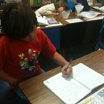A Sticky Situation

Author(s): Sarah Sue
Subject: Chemistry
Grade Level(s): Grade 5
Big Idea(s): In chemical changes, atoms are rearranged into new combinations.
What you need: (per partner group) 60 ML skim milk, 20ML vinegar, baking soda, scissors, precut vocabulary cards, numbered plastic cups (3), coffee filter, stir stick, procedure list (to be glued in prior to lesson), popsicle stick
Setting: Students work with a partner to complete the lab.
Time Needed: 50-60 minutes
Summary:
In this lesson, students will make functional glue and use it to adhere vocabulary cards into their science notebooks. While making the glue, they will watch for signs that a chemical reaction has occurred.
Learning Goals / Objectives:
Explain how substances entering into a chemical reaction are different from substances produced by a chemical reaction. Identify how to determine if a chemical change has taken place.
Background
Chemical reactions may occur between atoms or molecules. A common example is the formation of carbon dioxide. Fire can cause a chemical reaction between carbon atoms and oxygen molecules. The reactants, carbon and oxygen, are chemically changed into a product, carbon dioxide. Fire provides the energy needed for atoms and molecules to be rearranged.
Setup:
Materials can be pre-prepped with milk and vinegar premeasured and labeled for student use. Materials to be distributed by teacher or student team leaders. In an effort to save time, students will fill in the objective in their lab books prior to the start of the lesson. They will also form a hypothesis as to what they think will occur in the experiment at this time.
Anticipatory Set:
Teacher begins with a demo o how to make the glue and then uses it to adhere the vocabulary terms in to the science notebook.
Instructions / Activities:
1. 2 students per group, one is assigned partner “A”, the other “B.” These partners will be pre-assigned by teacher, making sure to form heterogeneous groups.
2. Add 20 ML of vinegar to the 60 ML of milk and stir the two liquids together. (these are pre-measured by teacher)
3. Partner A holds a large coffee filter over another plastic cup and partner B pours the mixture through the coffee filter.
4. Use a popsicle stick to scrape off the solid substance on the coffee filter and place it in a third plastic cup.
5. Add a fingernail-sized amount of baking soda to the third cup and stir to mix. (teacher will distribute)
6. Use the created glue to glue the vocabulary words in science notebook.
7. Record experiment findings in science notebook.
8. Answer assessment/review questions (“quick-check”) and turn in to teacher.
Assessment:
Students complete “quick check” review questions.
Students complete experiment write up in science notebook.
Students glue vocabulary words in notebook, demonstrating accurate completion of lab.
Wrap-up / Closure:
Reconvene with a whole class discussion of the glue making lab. Students share successes and areas of improvement in the glue making process. Make sure students understand why this process demonstrated a chemical change.

